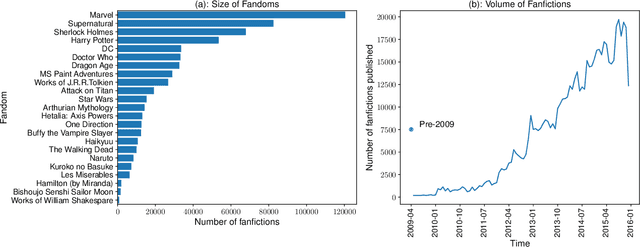Elise Jing
Identifying Introductions in Podcast Episodes from Automatically Generated Transcripts
Oct 14, 2021



Abstract:As the volume of long-form spoken-word content such as podcasts explodes, many platforms desire to present short, meaningful, and logically coherent segments extracted from the full content. Such segments can be consumed by users to sample content before diving in, as well as used by the platform to promote and recommend content. However, little published work is focused on the segmentation of spoken-word content, where the errors (noise) in transcripts generated by automatic speech recognition (ASR) services poses many challenges. Here we build a novel dataset of complete transcriptions of over 400 podcast episodes, in which we label the position of introductions in each episode. These introductions contain information about the episodes' topics, hosts, and guests, providing a valuable summary of the episode content, as it is created by the authors. We further augment our dataset with word substitutions to increase the amount of available training data. We train three Transformer models based on the pre-trained BERT and different augmentation strategies, which achieve significantly better performance compared with a static embedding model, showing that it is possible to capture generalized, larger-scale structural information from noisy, loosely-organized speech data. This is further demonstrated through an analysis of the models' inner architecture. Our methods and dataset can be used to facilitate future work on the structure-based segmentation of spoken-word content.
Characterizing Partisan Political Narratives about COVID-19 on Twitter
Mar 11, 2021



Abstract:The COVID-19 pandemic is a global crisis that has been testing every society and exposing the critical role of local politics in crisis response. In the United States, there has been a strong partisan divide which resulted in polarization of individual behaviors and divergent policy adoption across regions. Here, to better understand such divide, we characterize and compare the pandemic narratives of the Democratic and Republican politicians on social media using novel computational methods including computational framing analysis and semantic role analysis. By analyzing tweets from the politicians in the U.S., including the president, members of Congress, and state governors, we systematically uncover the contrasting narratives in terms of topics, frames, and agents that shape their narratives. We found that the Democrats' narrative tends to be more concerned with the pandemic as well as financial and social support, while the Republicans discuss more about other political entities such as China. By using contrasting framing and semantic roles, the Democrats emphasize the government's role in responding to the pandemic, and the Republicans emphasize the roles of individuals and support for small businesses. Both parties' narratives also include shout-outs to their followers and blaming of the other party. Our findings concretely expose the gaps in the "elusive consensus" between the two parties. Our methodologies may be applied to computationally study narratives in various domains.
Sameness Attracts, Novelty Disturbs, but Outliers Flourish in Fanfiction Online
Apr 16, 2019



Abstract:The nature of what people enjoy is not just a central question for the creative industry, it is a driving force of cultural evolution. It is widely believed that successful cultural products balance novelty and conventionality: they provide something familiar but at least somewhat divergent from what has come before, and occupy a satisfying middle ground between "more of the same" and "too strange". We test this belief using a large dataset of over half a million works of fanfiction from the website Archive of Our Own (AO3), looking at how the recognition a work receives varies with its novelty. We quantify the novelty through a term-based language model, and a topic model, in the context of existing works within the same fandom. Contrary to the balance theory, we find that the lowest-novelty are the most popular and that popularity declines monotonically with novelty. A few exceptions can be found: extremely popular works that are among the highest novelty within the fandom. Taken together, our findings not only challenge the traditional theory of the hedonic value of novelty, they invert it: people prefer the least novel things, are repelled by the middle ground, and have an occasional enthusiasm for extreme outliers. It suggests that cultural evolution must work against inertia --- the appetite people have to continually reconsume the familiar, and may resemble a punctuated equilibrium rather than a smooth evolution.
 Add to Chrome
Add to Chrome Add to Firefox
Add to Firefox Add to Edge
Add to Edge